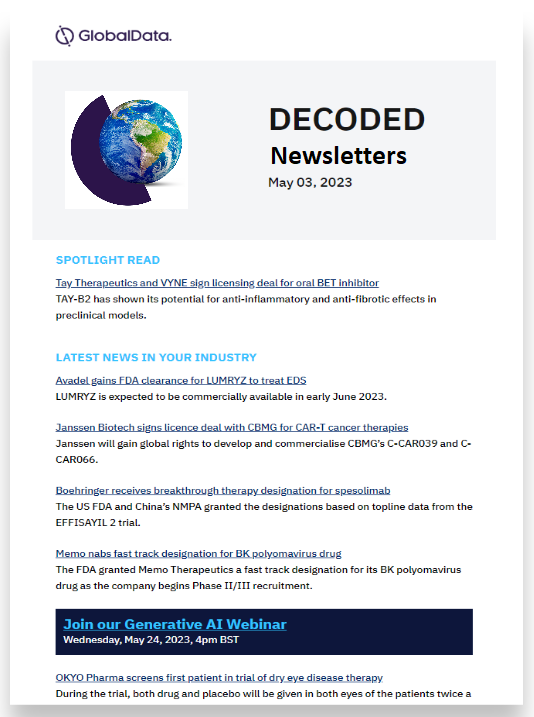
Technology DECODED
Previous edition: 14 May 2024
Share article
Get the full version straight to your inbox.
Exclusive access to our best-in-class data & intelligence
Subscribe now
Opinion: ABBYY CEO Ulf Persson shares how business leaders can tackle barriers to AI adoption
AI has been around and used for many years, with examples such as machine learning and natural language processing. From a user perspective, consider recommended playlists on Spotify and voice interaction with Siri as prime illustrations.

The emergence of large language models (LLMs) to generative and creative AI has dramatically changed both the reality and perception of what can be achieved with the help of AI. This has, naturally, put business leaders on notice. How can they improve their business using AI? What should they focus on first? There is a fear of being left behind if we don’t act fast, and rightfully so.
As business leaders look at AI strategies, they will see the vast opportunities. ITA figures show the UK AI market is already worth more than £16.8bn and expected to grow to £801.6bn by 2035.
Looking a bit closer, the constraints or barriers to adoption become apparent too. These include high costs, security concerns, lack of accuracy, and perhaps realisation that not all AI is a solution to all business problems.
So, how can we negotiate the barriers to adoption? Here are a few recommendations that may be helpful.
Put timing in context
It is less than two years since ChatGPT was launched. Newer versions have vastly improved output quality. Lately, we have seen the emergence of creative tools generating pictures and video with remarkable quality.
It is probable that AI tools will continue to develop at breakneck pace. This calls for a flexible AI strategy which allows for adoption of newer and improved capabilities. As the landscape evolves, organisations must remain agile, ready to embrace the latest advancements to stay competitive in today's dynamic market.
Rather than adopting a one-size-fits-all approach, it's essential for businesses to identify specific areas for improvement and expected outcomes. Advanced process intelligence tools offer valuable insights, including predictive capabilities and process simulation. This allows organisations to test digital transformation initiatives before full implementation.
Define the purpose, then use AI with purpose
Focus on specific areas, or use cases, where AI can make the biggest difference while keeping a close eye on cost versus return and risk. Explore the challenges with using LLMs, such as security concerns, accuracy, cost, and data transparency. In fact, figures from Sagacity show that UK businesses are losing £244bn annually due to poor data management.
With a clearly defined use case it becomes easier to determine how AI can improve the outcome cost-effectively. The two key words here – improve and cost-effectively – often means AI is used to augment other technologies. At ABBYY, we call it AI with a purpose.
To use an example from our field of activity, the accuracy and speed of intelligence document processing tools are improved with the use of AI at multiple steps in the process. This leads to better straight-through-processing, saving costs and improving quality. AI also increases the scope of what an IDP tool can do, including adding a document summary or highlighting action items.
Another aspect is internal (and external) trust and transparency. Successfully adopting AI on a strategic level inevitably means a culture shift. Business leaders should take senior and junior staff on the journey of understanding the technology, and communicate that AI is not meant to replace employees but will help them automate tasks and allow for improved utility, and job satisfaction, for staff who have previously been handling highly repetitive tasks.
TechRadar research found that 87% of employees feel that AI is positive in their working life, and 81% prefer to use a mix of human and AI to deal with problems. Another key aspect is the usage of client data. This is not a new problem – all ML models require data to train on – but it has been raised a notch by the usage of LLMs where data usage is harder to audit and the outcomes harder to explain (trustworthiness). This problem is highlighted in data from PwC Adoption Study that show 61% of business leaders can’t explain their AI-powered decisions.
Addressing AI regulation
Finally, governments are actively regulating the provision and use of AI tools. For example, The EU's AI Act comes into effect in May, and businesses that trade with the EU must be prepared. There appears to be different viewpoints across governments. UK Prime Minister Rishi Sunak has asserted that “The UK’s answer is not to rush to regulate … we believe in innovation … And in any case, how can we write laws that make sense for something we don’t yet fully understand?” In the US, the absence of federal AI regulation, could lead to patchwork legislation coupled with weak enforcement.
Companies must be aware of and prepare for future legislation when they make strategic AI investment decisions. When delving into the ethical considerations surrounding AI adoption, it's crucial to address bias in AI algorithms, ensure fairness, and uphold accountability. Purpose-built AI can make it easier to comply with the EU AI Act than broader models, which can cause challenges with compliance. Purpose-built AI simplifies compliance by tailoring models to specific tasks and regulations. This improves transparency, mitigates bias, and enables easier auditing.
AI is here to stay and will be a key feature for all business, whether in automation cost-efficiencies, decision-making support or customer interaction. While there may be immediate challenges in adopting AI, successfully mitigating these barriers will yield long-term benefits for businesses.
Embracing a focused and well thought-through approach to AI investment – AI with a purpose – will help businesses secure meaningful and quick wins from AI adoption. This will create a platform for further AI adoption while enhancing transparency and securing regulatory compliance. Importantly, it will also help businesses build internal AI competencies bridging technology advances with purposeful application and adoption.
Latest news

Analysis: will the UK AI bill do enough for businesses?
On Friday (10 May), the House of Lords heard the third reading of the UK’s AI bill, moving it into the next stage of being heard in the House of Commons.

CrowdStrike partners with Google Cloud on cybersecurity
US cybersecurity company CrowdStrike has partnered with Google Cloud to enhance Mandiant’s Incident Response and Managed Detected Response services for Google Cloud customers.

In data: web3 related patents soared in 2023
The number of web3 related patent publications soared 190 in 2023 according to research and analysis company GlobalData’s patent data base.

Network APIs may ‘drive whole new types of capabilities and applications'
Network application programming interfaces (APIs) will “drive whole new types of capabilities and applications” for both consumers and businesses if they are rolled out as widely as many in the industry expect them to be, according to analysts.

Business leaders consider cybersecurity main disruptor - Q1 2024 survey
74% of business leaders view cybersecurity as the main disruptive threat to their organisations either currently or over the next twelve months, according to GlobalData’s Tech Sentiment Polls Q1 2024 survey.

First Neuralink implant partially detaches from patient's brain
The first Neuralink implant in a human patient has partially detached from the patient’s brain weeks after it was implanted.
In our previous edition

Technology Decoded
Analysis: will the UK AI bill do enough for businesses?
13 May 2024

Technology Decoded
Analysis: will Microsoft's AI investment pay off?
10 May 2024

Technology Decoded
Analysis: Could UK self-driving unicorn Wayve overtake its competitors?
09 May 2024
Newsletters in other sectors
Aerospace, Defence & Security
Banking & Payments
Construction
Foodservice
Medical Devices
Travel and Tourism
Search companies, themes, reports, as well as actionable data & insights spanning 22 global industries
Access more premium companies when you subscribe to Explorer


